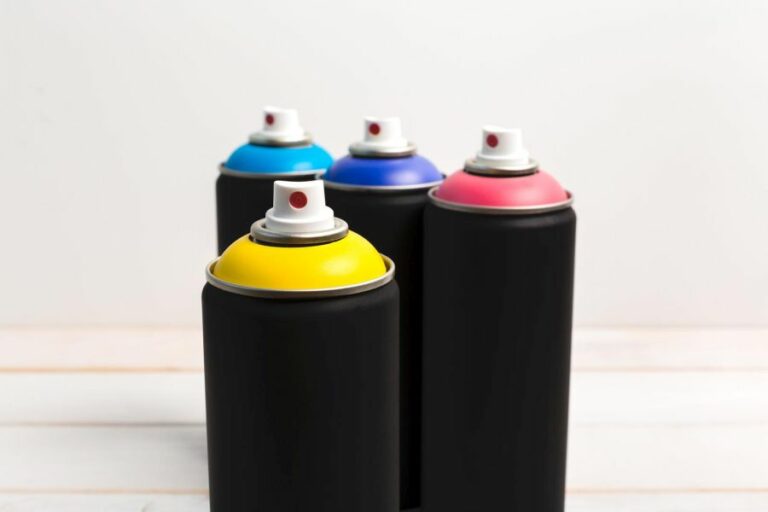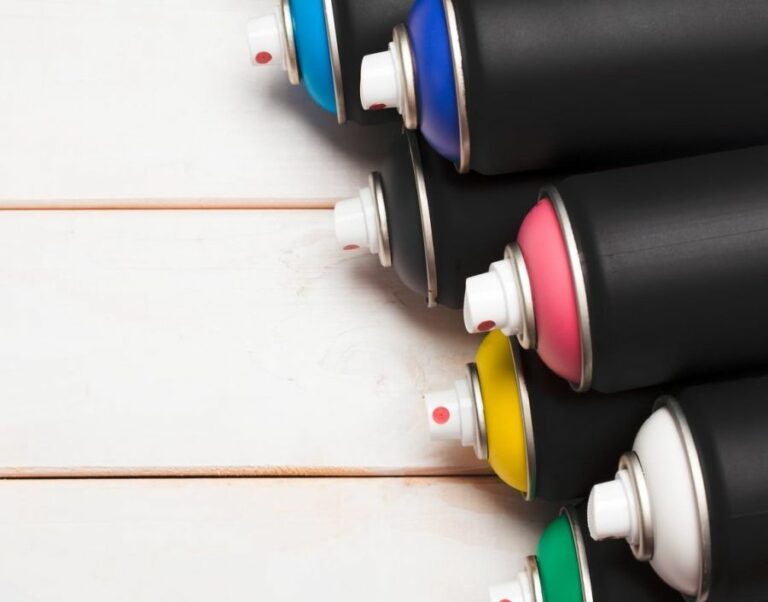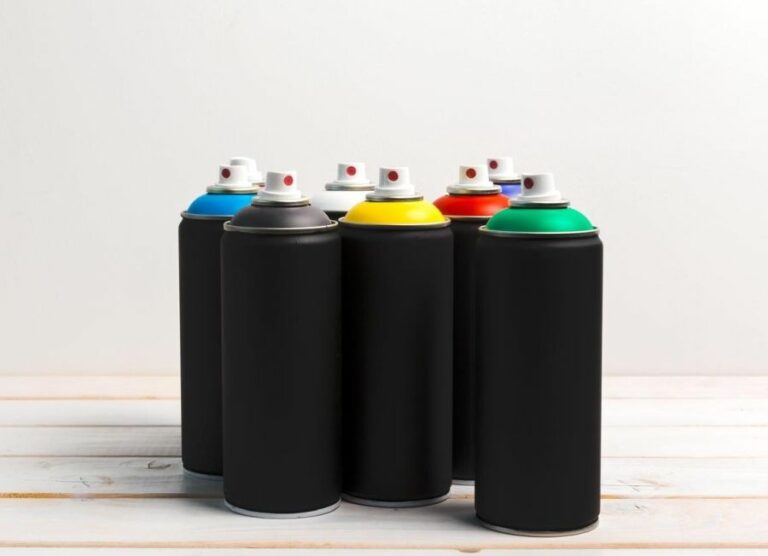Banish Spray Paint From Any Surface. What Pros Say
Are you struggling to remove unwanted spray paint from any surface, be it your walls, car, or furniture? Fret not because we’ve got you covered. With our foolproof methods and easy-to-follow guidance, you have nothing to fear as you’ll master the art of banishing spray paint in no time, restoring your surfaces to their former glory.
Banish spray paint from any surface:
To remove spray paint from various surfaces, use appropriate techniques and products. For metal, apply paint thinner, acetone, or rubbing alcohol; for wood, sand, and a wood-specific paint stripper; for glass, use a razor scraper; and for concrete, apply a biodegradable graffiti removal product. Always follow safety precautions, such as wearing protective gear and working in a well-ventilated area.

Tired of unsightly spray paint ruining your property? Don’t worry; we’re here to help! Our article provides effective techniques to banish spray paint from various surfaces. Keep reading to reclaim your space and restore it to its original glory!
Contents
- 1 Eliminate Spray Paint from Various Surfaces
- 2 Methods for Spray Paint Removal on Surfaces
- 3 Safely Remove Spray Paint from Surfaces
- 4 Techniques for Removing Spray Paint from Metal
- 5 Strip Paint without Affecting the Underlying Layer
Eliminate Spray Paint from Various Surfaces
• Introduction to Removing Spray Paint
Removing spray paint from various surfaces can be a daunting task, especially if the graffiti or unwanted paint has been there for some time. Fear not, as there are effective ways to strip away the spray paint and restore the surface to its original glory. This guide will outline the right techniques, tools, and products needed to tackle even the most stubborn stains.
• Types of Surfaces and Appropriate Removal Techniques
When it comes to removing spray paint from a surface, it’s essential first to identify the material in question. Different surfaces require different methods to avoid causing any permanent damage.
– Metal Surfaces
For metal surfaces, such as outdoor furniture, gates, and mailboxes, paint thinner, acetone, or even strong rubbing alcohol will often do the trick.
Soak a cloth or sponge in the paint remover of your choice (paint thinner, acetone, or rubbing alcohol). Gently rub the affected area in a circular motion until you see the spray paint starting to dissolve. Rinse the surface with water, and pat it dry with a clean towel.
For stubborn spray paint on metal surfaces, I recommend trying a graffiti removal product specifically designed for metal surfaces, such as Goof Off Graffiti Remover.
– Wood Surfaces
Removing spray paint from wood surfaces like decks, fences, and furniture can be quite challenging, as the paint tends to penetrate the wood’s porous surface.
Begin by lightly sanding the affected area with fine-grit sandpaper. Following sanding, use a paint stripper specifically designed for wood surfaces; these can be found at most home improvement stores.
Apply the stripper to the affected area using a brush, then let it sit for the amount of time specified on the product’s packaging. Scrape away the softened paint with a plastic scraper, taking care not to scratch the wood.
Finally, clean the area with a damp cloth, followed by a dry cloth, to remove any residue.
– Glass Surfaces
You may encounter spray paint on glass surfaces, like windows or mirrors. In these cases, a razor scraper is your best tool.
Make sure your scraper is clean and sporting a fresh, sharp blade. Hold the blade at a 45-degree angle and gently scrape the paint off the glass.
For any remaining residue, use a mixture of warm water and mild detergent, apply it to the affected area with a sponge, and then wipe clean with a dry cloth.
– Concrete Surfaces
Street art, unwanted graffiti, or accidental overspray may affect concrete surfaces like sidewalks, garages, or outdoor walls. Removing spray paint from concrete requires a combination of techniques.
Begin by applying a biodegradable, alkaline graffiti removal product, like Elephant Snot, following the manufacturer’s instructions. Let the product sit on the surface for the recommended amount of time, usually around 20-30 minutes.
Using a stiff-bristled brush or broom, scrub the treated area. Rinse the surface with a high-pressure water hose to wash away any remaining residue, being mindful of any environmental regulations in your area for waste disposal.
• Safety Precautions When Removing Spray Paint
It’s essential to take proper safety measures when working with chemicals and paint removal products. Here’s a list of recommended safety precautions:
Wear protective gloves, eye protection, and clothing that covers exposed skin. Work in a well-ventilated area, preferably outdoors, to avoid inhaling chemical fumes.
Avoid working near open flames, as some paint removal chemicals are flammable. Follow any additional safety precautions specified on your chosen paint removal product.
• Final Thoughts
Removing spray paint can be a frustrating task, but with patience and the right techniques, it can be accomplished. Keep in mind that no single method or product may work for every surface, and you may need to experiment with different approaches.
Always remember to follow safety precautions and adhere to local waste disposal regulations.
Methods for Spray Paint Removal on Surfaces
Removing spray paint from various surfaces can be a daunting task, especially when dealing with stubborn stains or delicate materials. However, with the right knowledge, tools, and techniques, it can be done effectively and safely.
• Removing Spray Paint from Metal
– Step 1: Use a Paint Thinner or Remover
For metal surfaces, using paint thinner or paint remover, such as acetone or mineral spirits, can be highly effective for removing spray paint. Apply the paint thinner on a cloth or sponge and gently scrub the affected area until the paint starts to come off.
– Step 2: Use a Fine Steel Wool or Sandpaper
If the paint thinner does not work or if the paint has dried, use fine steel wool or sandpaper to gently scrub the area. Be careful not to apply too much pressure to avoid scratching the metal surface.
– Step 3: Rinse and Wipe the Surface
After successfully removing the spray paint, rinse the area with water and wipe it dry using a clean cloth.
• Removing Spray Paint from Wood
– Step 1: Scrape the Excess Paint
For wooden surfaces, start by using a plastic scraper or a wooden spatula to gently remove any excess paint from the surface. Be cautious not to damage the wood while scraping.
– Step 2: Apply Paint Thinner or Remover
Similar to metal surfaces, use a paint thinner or removers like acetone or mineral spirits. Apply it on a clean cloth and gently rub the area until the paint starts to come off.
– Step 3: Use Sandpaper
If needed, use fine-grit sandpaper to remove any remaining paint. Start with a higher grit and work your way down until the paint is completely removed. Be cautious not to sand too deep and damage the wood.
– Step 4: Clean and Refinish
After removing the paint, wipe down the area with a damp cloth to remove any residue from the paint remover. Depending on the damage caused during the removal process, you may want to consider refinishing the wood.
• Removing Spray Paint from Plastic
– Step 1: Use Mild Soap and Water
For plastic surfaces, start by using mild soap and water to clean the area. This can help soften the paint and make it easier to remove.
– Step 2: Apply a Cooking Oil
If the paint does not come off with soap and water, try using a tablespoon of cooking oil, such as vegetable oil or olive oil. Apply the oil onto a clean cloth and gently rub it over the paint-stained area.
– Step 3: Use a Plastic Scraper
Gently use a plastic scraper to lift off the paint. Be careful not to scratch or damage the plastic surface.
– Step 4: Clean the Surface
After successfully removing the spray paint, clean the area with mild soap and water again to remove any residue.
• Removing Spray Paint from Glass
– Step 1: Scrape the Paint
For glass surfaces, start by using a razor blade or a plastic scraper to gently remove the spray paint.
– Step 2: Apply Glass or Window Cleaner
If some paint remains, use a glass or window cleaner and rub the area with a clean cloth until the paint is removed.
– Step 3: Rinse and Wipe the Surface
After removing the paint, rinse the area with water and wipe it dry using a clean cloth.
• Removing Spray Paint from Concrete
– Step 1: Use a Pressure Washer or Hose
For concrete surfaces, start by using a pressure washer or a garden hose with a nozzle attachment to wash away any loose paint particles.
– Step 2: Apply a Paint Thinner or Remover
Next, apply paint thinner or paint remover such as acetone or mineral spirits on a clean cloth and gently rub the area until the paint starts to come off.
– Step 3: Use a Wire Brush
If needed, use a wire brush to scrub the remaining paint. Be cautious not to damage the concrete surface.
– Step 4: Rinse and Clean the Surface
After removing the spray paint, rinse the area with water, and sweep away any remaining paint particles.
• Conclusion
Removing spray paint from different surfaces can be challenging. However, with the right techniques and tools, it can be done effectively and safely. Always remember to test a small area before applying any chemicals or sharpened tools to ensure that you do not damage or discolor the surface.
Surface Type | Removal Method |
|---|---|
Wood | Use a paint scraper or sandpaper to gently remove the spray paint. Alternatively, use a paint remover or paint thinner solution. |
Metal | Apply a paint thinner or acetone to a cloth and gently rub the affected area. Alternatively, use fine steel wool to scrub the paint off. |
Glass | Use a razor blade or a glass scraper to carefully scrape off the paint. Alternatively, apply acetone, rubbing alcohol, or a paint thinner to a cloth and gently rub the area. |
Plastic | Apply a small amount of paint thinner or plastic-safe paint remover to a cloth and gently rub the area. Be careful not to apply too much pressure, as it may damage the plastic surface. |
Concrete/Brick | Use a pressure washer or sandblaster to remove the spray paint. In some cases, a paint remover or paint stripper solution may also be effective. |
Safely Remove Spray Paint from Surfaces
Spray paint can be a nuisance when it ends up on unintended surfaces. Finding methods to safely and effectively remove it is crucial to preserve the original material.
• Understanding the Surface Material
Before attempting to remove spray paint from any surface, it’s essential to know what material you’re working with. Different materials will require different cleaning solutions and techniques to avoid damage.
– Nonporous Surfaces
These include metals, glass, and plastics. Nonporous surfaces are usually smooth and easier to clean, as they do not absorb paint.
– Porous Surfaces
Porous surfaces, such as wood, brick, and concrete, have pores or small openings that allow paint to seep in, making it more challenging to remove.
• Safety Precautions
When handling spray paint removal products, ensure proper safety gear such as gloves, masks, and goggles are worn. Work in well-ventilated areas, and always read and follow the instructions provided on product labels.
• Nonporous Surface Techniques
– Soapy Water
This method is recommended for fresh spray paint stains. Begin by mixing warm water with a few drops of dish soap. Apply the soapy solution onto the stained area using a soft sponge. Gently rub the surface, working in circular motions. Rinse the area with clean water and pat dry with a cloth.
– Acetone or Nail Polish Remover
Acetone or acetone-based nail polish remover can be effective in removing spray paint from nonporous surfaces. Apply a small amount onto a clean cloth or cotton ball and rub it gently onto the stained area.
Be cautious, as acetone can sometimes dissolve certain plastics or coatings. Proceed with caution and test on a small, inconspicuous area first.
– Rubbing Alcohol
Rubbing alcohol is a versatile solvent helpful in dissolving spray paint. Soak a clean cloth or cotton ball with rubbing alcohol and apply it to the stain, rubbing gently until the paint begins to lift. Rinse the area with clean water and pat dry.
– Graffiti Remover
Several commercially available graffiti removers can be used to remove spray paint from nonporous surfaces. Popular options include Goof Off, Motsenbocker’s Lift Off, and Krud Kutter. Follow the product’s directions and test on a small, inconspicuous area first.
• Porous Surface Techniques
– Sanding
For wooden surfaces, sanding is an option. Start with coarse-grit sandpaper (60 to 80 grit) to remove the majority of the spray paint.
Gradually move to finer grits (120 to 220 grit) to finish the job and restore the wood’s appearance. Once the sanding is complete, apply a wood finish or paint to seal the surface.
– Pressure Washing
Pressure washing can be an effective method for removing spray paint from brick or concrete surfaces. Ensure to use a low-pressure setting to avoid damaging the surface. It is advisable to start in an inconspicuous area to test the technique and find the appropriate pressure setting.
– Poultice
A poultice can be created by mixing an absorbent substance, like diatomaceous earth or talcum powder, with a strong solvent, such as acetone, lacquer thinner, or xylene.
Spread the paste onto the painted surface, covering it completely. Allow it to sit for 24 hours, keeping it moist with a damp cloth. Once dried, gently scrape the mixture off, taking the paint with it. Caution: test on a small area first, and use appropriate safety gear.
– Soda Blasting
Soda blasting is a more aggressive method for removing spray paint from porous surfaces. In this technique, sodium bicarbonate (baking soda) is blasted onto the surface using specialized equipment. The force and abrasiveness of the soda will remove the paint without damaging the surface.
This method should be performed by a professional or someone with adequate experience.
• Post-Removal Tips
Once the spray paint has been removed, clean the area with soapy water to remove any residue. Rinse thoroughly and pat dry.
For surfaces that require a protective coating or finish, apply the appropriate product to prevent future damage and preserve the surface’s appearance.
• Conclusion
In conclusion, it is possible to remove spray paint without causing damage to various surfaces. The key is understanding the material, using appropriate cleaning solutions and techniques, and exercising patience and caution throughout the process.
Utilize the provided methods and prioritize safety to achieve successful spray paint removal.
Step | Method | Description |
|---|---|---|
1 | Test in an inconspicuous area | Before using any method, test it on a small, hidden part of the surface to ensure it will not cause damage. |
2 | Use a mild solution | Start with a mild solution like soap and warm water, using a soft cloth or sponge. Gently rub the paint until it starts to soften or come off |
3 | Use a paint thinner or remover | If soap and water are not effective, move on to using a paint thinner or remover. Make sure to choose a product that is safe for the surface you are working on. |
4 | Apply the remover and scrub gently | Apply the paint thinner or remover onto a cloth or sponge, and gently rub the paint in a circular motion. Do not apply excessive pressure and make sure to follow the manufacturer’s instructions. |
5 | Wipe away the loosened paint | Once the paint starts to soften or come off, use a clean cloth or sponge to wipe away the residue. Continue the process until the paint is removed completely. |
6 | Clean the surface | After the paint is removed, clean the surface with soap and water to remove any leftover residue. |
Techniques for Removing Spray Paint from Metal
Removing spray paint from metal surfaces can be a challenging task. Over time, spray paint can bond strongly to the metal surface, and removing it requires a combination of products, tools, and techniques.
• Mineral Spirits
Mineral spirits are mild solvents that can help dissolve and remove spray paint from metal surfaces. It’s important to ensure proper ventilation when using mineral spirits and wear gloves to protect your skin.
How to Use Mineral Spirits:
- Apply the mineral spirits to a clean cloth or sponge.
- Gently rub the painted area of the metal with the cloth or sponge, applying steady pressure.
- Continuously change the cloth or sponge as the paint is removed to prevent reapplying the paint to the surface.
- Once the paint is removed, clean the surface with soap and water to remove any residual mineral spirits.
Mineral spirits may not be effective for all types of spray paint. If you find the paint is not coming off easily, try using a different method.
• Paint Thinner
Paint thinner is a strong solvent that can dissolve spray paint on metal surfaces. It is more potent than mineral spirits, so proper ventilation is essential when using paint thinner, and gloves should be worn to protect your skin.
How to Use Paint Thinner:
- Apply the paint thinner to a clean cloth or sponge.
- Gently rub the painted area of the metal with the cloth or sponge, applying steady pressure.
- Continuously change the cloth or sponge as the paint is removed to prevent reapplying the paint to the surface.
- Once the paint is removed, clean the surface with soap and water to remove any residual paint thinner.
It is essential to follow the manufacturer’s instructions when using paint thinner to avoid potential damage to the metal.
• Graffiti Removers
Various commercial graffiti removers are specifically designed to remove spray paint from metal surfaces. These products contain powerful solvents that can dissolve and lift away the paint. Many of these products are available at local hardware or home improvement stores.
How to Use Graffiti Removers:
- Follow the manufacturer’s instructions on the specific graffiti remover product you choose.
- Apply the graffiti remover to the painted area of the metal.
- Allow the remover to sit for the recommended time.
- Gently scrub the affected area with a cloth or sponge, applying steady pressure.
- Continuously change the cloth or sponge as the paint is removed to prevent reapplying the paint to the surface.
- Once the paint is removed, clean the surface with soap and water to remove any residual graffiti remover.
When using graffiti removers, be sure to follow the manufacturer’s recommendations for safety and proper use.
• Abrasive Techniques
In some cases, abrasive techniques may be necessary to remove stubborn spray paint from metal surfaces. These methods involve using a mechanical or manual tool to physically scrape or sand away the paint.
Wire Brush:
Using a wire brush can help to scrape away the spray paint from the metal surface. This technique can be effective for small or localized areas of paint.
- Gently scrape the painted area with the wire brush, applying steady pressure.
- Be cautious not to scratch or damage the underlying metal.
- Once the paint is removed, clean the surface with soap and water to remove any debris.
Sandpaper:
Using sandpaper can be effective in removing spray paint from larger metal surfaces.
- Start with coarse-grit sandpaper (80-120 grit) to remove the majority of the paint.
- Gradually switch to medium-grit (120-180 grit) and fine-grit (180-220 grit) sandpaper to smooth out the metal surface.
- Once the paint is removed and the surface smoothed, clean the area with soap and water to remove any debris.
Both wire brushes and sandpaper can cause damage to the underlying metal if used excessively or improperly. Use these methods with caution.
• Power Tools
For large-scale spray paint removal or cases where the paint is highly resistant to other methods, power tools such as grinders or sanders can be used. These tools are best left for experienced users and may require additional safety measures, such as eye protection and proper ventilation.
Examples of Power Tools for Spray Paint Removal:
- Angle grinder with a wire cup brush or abrasive pad attachment
- Orbital sander with various grits of sandpaper
- Power drill with a wire wheel or abrasive pad attachment
When using power tools, be aware of the potential for injury or damage to the metal surface. Follow all safety guidelines recommended by the tool’s manufacturer.
• Additional Tips
- Test the chosen method in a discreet, small area of the metal surface to ensure it doesn’t cause further damage.
- When using a solvent-based method, allow the metal surface to dry thoroughly before applying any new paint or finish.
- Keep in mind that painted surfaces may have layers of older paint or coatings. Multiple methods may be required to remove all layers.
- Dispose of any used solvents, paint residues, or abrasive materials according to your local waste disposal regulations.
Remember, patience and persistence are key when removing spray paint from metal surfaces. Choose the appropriate method based on the paint type, metal surface, and your experience level for the best results.
Strip Paint without Affecting the Underlying Layer
Removing unwanted paint can be quite challenging, especially when you are trying to preserve the underlying original paint. Fortunately, this guide will share some effective methods and practical tips to help you strip away unwanted paint while leaving the original paint intact.
• Determine the Type of Paint
Before attempting to remove any paint, it’s crucial to identify the type of paint you’re working with. Knowing the paint type will let you choose the appropriate removal method and chemicals. Paint can typically be categorized into two main types: oil-based paints and water-based paints.
- Water-based paints: These are often referred to as latex or acrylic paints. If the paint becomes soft and sticky when rubbed with a cloth soaked in denatured alcohol, it is likely water-based.
- Oil-based paints: These are also known as alkyd paints. If the paint does not soften when exposed to alcohol but does when exposed to mineral spirits, it is most likely oil-based.
If you are uncertain about the paint type, it is best to consult a professional or research further to avoid causing any damage to the original paint.
• Use Heat to Remove Paint
One effective way of removing paint without harming the original paint beneath is by using heat. A heat gun or a hairdryer can be used to soften the unwanted paint, making it easier to remove.
– Step-by-Step Guide
- Gather necessary materials: You will need a heat gun or hairdryer, a plastic scraper, and a clean cloth.
- Apply heat: Set the heat gun or hairdryer to a low setting and keep it at least 6 inches away from the surface. Slowly move the heat source over the unwanted paint until it begins to soften.
- Scrape off the paint: Carefully use the plastic scraper to remove the softened paint. Be sure to hold the scraper at a shallow angle to avoid scratching the original paint.
- Clean the area: After removing the paint, use a clean cloth to wipe away any residue.
Note: It is essential to work in a well-ventilated area while using heat to remove paint, as fumes from the paint may be harmful.
• Use a Chemical Paint Remover
Chemical paint removers can also be useful for removing paint without damaging the underlying original paint. There are various types of paint removers available, such as:
- Soy-based or bio-based paint removers: These are environmentally friendly and less toxic compared to traditional chemical paint removers.
- Solvent-based paint removers: They are effective for removing oil-based paints but can be quite harsh and may damage some surfaces.
- Caustic-based paint removers: They are best suited for removing multiple layers of paint but should be used cautiously as they can be corrosive.
Important: Always test the paint remover on a small, inconspicuous area first to ensure it will not damage the original paint. It is wise to select a paint remover specifically designed for the type of paint you are trying to remove.
– Step-by-Step Guide
- Gather necessary materials: You need a paint remover, paintbrush or cloth, plastic scraper, gloves, and protective eyewear.
- Prepare the surface: Ensure the surface is clean and dry before applying the paint remover.
- Apply the paint remover: Follow the manufacturer’s instructions and apply a thin layer of the paint remover using a paintbrush or cloth. Allow it to sit for the recommended time.
- Scrape off the paint: Gently use the plastic scraper to remove the loosened paint. Be cautious not to scratch the original paint underneath.
- Clean the area: After stripping the paint, use a clean cloth to remove any residue from the surface.
• Choose a Mechanical Paint Removal Method
In some cases, mechanical methods can be employed to remove paint without damaging the original paint. These methods should be used with caution and only if absolutely necessary, as they may cause some damage to the surface.
– Sanding
Sanding can be an effective way to remove unwanted paint, particularly if the paint layer is relatively thin. It is essential to use fine-grit sandpaper (such as 220 grit) and a gentle touch to avoid damaging the original paint. Additionally, using a sanding block can help prevent uneven pressure distribution.
– Power Tools
Some power tools, such as orbital sanders and rotary tools with soft abrasive attachments, can be used to remove paint carefully. However, these methods should be reserved for when all other options have been exhausted, as they pose the highest risk of damaging the original paint.
• Additional Tips
- When using chemicals, always wear gloves and protective eyewear and work in a well-ventilated area.
- Have patience and work slowly to minimize the risk of damaging the original paint.
- If you are unsure about how to proceed or feel overwhelmed by the process, consult a professional for guidance.
• Conclusion
In conclusion, there are several methods you can employ to remove unwanted paint without damaging the original paint underneath. Key factors to remember include identifying the type of paint, using appropriate techniques and materials, and working carefully to prevent potential damage.
Method | Description | Materials Needed |
|---|---|---|
Using a scraper or plastic spatula | Gently scrape off the unwanted paint, making sure to not apply too much pressure to avoid damaging the original paint. | Scraper or plastic spatula, cloth |
Applying a paint remover | Apply a paint remover designed specifically for removing paint without damaging the original paint, following the manufacturer’s instructions. | Paint remover, cloth, gloves, paintbrush, scraper or plastic spatula |
Using rubbing alcohol or acetone | Test an inconspicuous area first to make sure it doesn’t damage the original paint. Apply a small amount of rubbing alcohol or acetone to a cloth, then gently rub the unwanted paint until it loosens and comes off. | Rubbing alcohol or acetone, cloth or sponge |
Using a heat gun or hair dryer | Apply heat to the unwanted paint using a heat gun or a hair dryer while gently scraping it off with a scraper or a plastic spatula as it softens. | Heat gun or hair dryer, scraper or plastic spatula, gloves |
Wet sanding with fine-grit sandpaper | Wet the fine-grit sandpaper and gently sand the unwanted paint, working in a circular motion. Be cautious not to sand the original paint underneath. | Fine-grit sandpaper, water, cloth |







